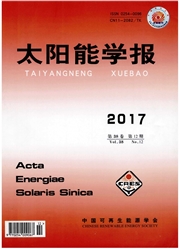

 中文摘要:
中文摘要:
为研究偏心环形单元内月桂酸的融化特性并对单元的结构进行优化,在保证一定量的相变材料时,改变圆环内外径,同时设置偏心来提高融化速率,为有空间限制的换热器设计等提供设计思路。采用焓-多孔介质模型对偏心单元内月桂酸的融化过程进行数值模拟,从相界面、融化分数、温度场、平均对流传热系数及储能量等方面与同心单元进行对比分析,在此基础上进行环形单元的结构优化设计。发现特征尺寸为20mm的环形单元在80℃工况下,融化分数增幅从偏心3mm单元的13.3%至偏心7.5mm单元的33.5%,偏心7.5mm单元的平均对流传热系数比同心单元提高了148.8%,储能量增量从偏心3mm单元的6.2%至偏心7.5mm单元的15.1%。结果表明:偏心单元比同心单元融化更快,单元内温度更低,平均对流传热系数更高,潜热储能效果更好,特征尺寸为20mm的单元的最优偏心距离为7~8mm。
 英文摘要:
英文摘要:
In order to study the melting heat transfer characteristics of lauric acid in eccentric unit and optimize the structure design, the inner and outer diameter of annulus were changed when a certain amount of phase change material was ensured, eccentricity was simultaneously set to increase the melting rate, the ideas for the heat exchanger design with space restriction were provided. Enthalpy-porous medium model was used to simulate numerically the melting process of lauric acid in eccentric unit. The optimum design for structure of ring unit was carried out based on comparative analyses of melting phase interface, melt fraction, temperature field, average convection heat transfer coefficient and energy storage etc. between eccentric unit and concentric unit. It was found that melt fraction increased from 13.3% in the eccentric 3 mm unit to 33.5% in the eccentric 7.5 mm unit for the unit of feature size of 20 mm at 80 ℃ operating condition; the average convective heat transfer coefficient in eccentric 7.5 mm unit was improved 148.8% compared with concentric unit and the energy storage increases from 6.2% in eccentric 3 mm unit to 15.1% in eccentric 7.5 mm unit. The resuhs show that the melting is faster, the temperature in unit is lower, the average convective heat coefficient is higher and the latent heat storage effect is better in eccentric unit than in concentric unit. The optimal eccentric distance is 7-8 mm for the unit of feature size of 20 mm.
 同期刊论文项目
同期刊论文项目
 同项目期刊论文
同项目期刊论文
 期刊信息
期刊信息
